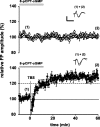Long-term potentiation in the visual cortex requires both nitric oxide receptor guanylyl cyclases
- PMID: 17251421
- PMCID: PMC6672906
- DOI: 10.1523/JNEUROSCI.4706-06.2007
Long-term potentiation in the visual cortex requires both nitric oxide receptor guanylyl cyclases
Abstract
The role of nitric oxide (NO)/cGMP signaling in long-term potentiation (LTP) has been a lingering matter of debate. Within the cascade, the NO receptor guanylyl cyclase (GC), the cGMP-forming enzyme that is stimulated by NO, plays a key role. Two isoforms of GC (alpha2-GC, alpha1-GC) exist. To evaluate their contribution to synaptic plasticity, we analyzed knock-out mice lacking either one of the GC isoforms. We found that LTP induced in the visual cortex is NO dependent in the wild-type mice, absent in either of the GC isoform-deficient mice, and restored with application of a cGMP analog in both strains. The requirement of both NO receptor GCs for LTP indicates the existence of two distinct NO/cGMP-mediated pathways, which have to work in concert for expression of LTP.
Figures




Similar articles
-
More than a retrograde messenger: nitric oxide needs two cGMP pathways to induce hippocampal long-term potentiation.J Neurosci. 2009 Jul 22;29(29):9344-50. doi: 10.1523/JNEUROSCI.1902-09.2009. J Neurosci. 2009. PMID: 19625524 Free PMC article.
-
Genetic mouse models of the NO receptor 'soluble' guanylyl cyclases.Handb Exp Pharmacol. 2009;(191):33-46. doi: 10.1007/978-3-540-68964-5_3. Handb Exp Pharmacol. 2009. PMID: 19089324 Review.
-
Presynaptic nitric oxide/cGMP facilitates glutamate release via hyperpolarization-activated cyclic nucleotide-gated channels in the hippocampus.Eur J Neurosci. 2011 May;33(9):1611-21. doi: 10.1111/j.1460-9568.2011.07654.x. Epub 2011 Mar 17. Eur J Neurosci. 2011. PMID: 21410795
-
Postsynaptic NO/cGMP increases NMDA receptor currents via hyperpolarization-activated cyclic nucleotide-gated channels in the hippocampus.Cereb Cortex. 2014 Jul;24(7):1923-36. doi: 10.1093/cercor/bht048. Epub 2013 Feb 28. Cereb Cortex. 2014. PMID: 23448871
-
Sequential activation of soluble guanylate cyclase, protein kinase G and cGMP-degrading phosphodiesterase is necessary for proper induction of long-term potentiation in CA1 of hippocampus. Alterations in hyperammonemia.Neurochem Int. 2004 Nov;45(6):895-901. doi: 10.1016/j.neuint.2004.03.020. Neurochem Int. 2004. PMID: 15312984 Review.
Cited by
-
Characterization of nitric oxide in Octopus maya nervous system and its potential role in sensory perception.Biol Open. 2024 Dec 15;13(12):bio061756. doi: 10.1242/bio.061756. Epub 2024 Nov 28. Biol Open. 2024. PMID: 39607019 Free PMC article.
-
RNA splicing in regulation of nitric oxide receptor soluble guanylyl cyclase.Nitric Oxide. 2011 Oct 30;25(3):265-74. doi: 10.1016/j.niox.2011.08.001. Epub 2011 Aug 16. Nitric Oxide. 2011. PMID: 21867767 Free PMC article. Review.
-
Nitric oxide-dependent long-term depression but not endocannabinoid-mediated long-term potentiation is crucial for visual recognition memory.J Physiol. 2013 Aug 15;591(16):3963-79. doi: 10.1113/jphysiol.2013.254862. Epub 2013 May 13. J Physiol. 2013. PMID: 23671159 Free PMC article.
-
Plasticity between neuronal pairs in layer 4 of visual cortex varies with synapse state.J Neurosci. 2009 Dec 2;29(48):15286-98. doi: 10.1523/JNEUROSCI.2980-09.2009. J Neurosci. 2009. PMID: 19955381 Free PMC article.
-
Pain modulation by nitric oxide in the spinal cord.Front Neurosci. 2009 Sep 15;3(2):175-81. doi: 10.3389/neuro.01.024.2009. eCollection 2009 Sep. Front Neurosci. 2009. PMID: 20011139 Free PMC article.
References
-
- Arancio O, Kiebler M, Lee CJ, Lev-Ram V, Tsien RY, Kandel ER, Hawkins RD. Nitric oxide acts directly in the presynaptic neuron to produce long-term potentiation in cultured hippocampal neurons. Cell. 1996;87:1025–1035. - PubMed
-
- Artola A, Singer W. Long-term potentiation and NMDA receptors in rat visual cortex. Nature. 1987;330:649–652. - PubMed
-
- Bear MF. Mechanism for a sliding synaptic modification threshold. Neuron. 1995;15:1–4. - PubMed
-
- Bellamy TC, Garthwaite J. The receptor-like properties of nitric oxide-activated soluble guanylyl cyclase in intact cells. J Mol Cell Biochem. 2002;230:165–176. - PubMed
Publication types
MeSH terms
Substances
LinkOut - more resources
Full Text Sources
Molecular Biology Databases
Miscellaneous
